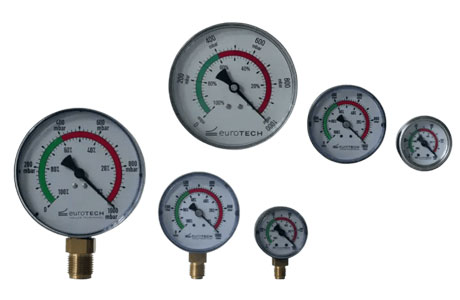What Is The Typical Accuracy Range Of A Pressure Gauge?
Key Takeaway
The typical accuracy range of a pressure gauge is between ±0.1% and ±2.5% of its full-scale reading. Higher-accuracy gauges, like those with ±0.1% or ±0.25%, are ideal for precision tasks.
General-purpose gauges, often within ±1% to ±2%, are used where high precision is not critical. Always choose an accuracy level suitable for your specific application.
Understanding Accuracy Classes in Pressure Gauges
Accuracy classes in pressure gauges refer to the degree of precision with which a pressure gauge can measure and indicate pressure levels. These accuracy classes are typically expressed as a percentage of the full-scale range, with lower percentages indicating higher precision. Understanding accuracy classes is crucial for selecting the appropriate gauge for specific applications, ensuring that pressure measurements are reliable and accurate.
Different industries require varying levels of accuracy, depending on the criticality of pressure measurements in their operations. For example, laboratory settings may demand highly accurate gauges, while less precision may be acceptable in other applications. By understanding and selecting the correct accuracy class, operators can enhance process control, safety, and efficiency in their systems.

Factors Affecting Pressure Gauge Accuracy
Pressure gauge accuracy is influenced by several key factors that must be considered to ensure precise measurements. Firstly, the quality and design of the gauge itself are crucial. High-quality materials and precise engineering can significantly enhance accuracy. The gauge should be properly calibrated at the factory, and regular recalibration is necessary to maintain its accuracy over time. Environmental conditions such as temperature, humidity, and exposure to aggressive chemicals can also affect the gauge’s performance. It is essential to select a gauge that is designed to withstand the specific conditions of its application to prevent inaccuracies caused by environmental factors.
Secondly, installation and maintenance play vital roles in the accuracy of pressure gauges. Improper installation, such as mounting the gauge in a position where it experiences excessive vibration or is exposed to mechanical shock, can lead to errors. Regular maintenance, including cleaning and checking for any signs of wear or damage, is necessary to ensure the gauge continues to provide accurate readings. Additionally, using the gauge within its specified pressure range is critical, as exceeding this range can cause permanent damage and result in inaccurate readings.
Finally, user error can impact the accuracy of a pressure gauge. Operators must be adequately trained to read the gauge correctly and interpret the results accurately. Misreading the scale or failing to account for any necessary corrections, such as atmospheric pressure adjustments, can lead to significant errors. Providing operators with clear instructions and training on best practices for using and maintaining pressure gauges can help minimize the risk of user-related inaccuracies. In summary, to ensure the accuracy of pressure gauges, attention must be paid to the quality of the gauge, proper installation and maintenance, and operator training and awareness.
Comparison of Accuracy Ranges in Different Gauge Types
Accuracy varies significantly among different types of pressure gauges. Here’s a quick comparison:
Bourdon Tube Gauges: Typically offer an accuracy range of 0.5% to 2%, making them suitable for general industrial applications.
Digital Pressure Gauges: Known for their high precision, with accuracy ranges as tight as 0.1% to 0.25%. Ideal for laboratory and testing environments.
Diaphragm Gauges: Provide accuracy between 0.5% to 1.5%, often used in low-pressure applications.
Capsule Gauges: Have accuracy levels of 1% to 2%, designed for measuring low-pressure differentials.
Selecting the right type of gauge depends on your application’s accuracy requirements and operational conditions.
Applications Requiring High-Accuracy Gauges
Some industries demand highly accurate pressure readings to ensure safety, efficiency, and compliance. These include:
1. Pharmaceuticals: Precise pressure measurements are crucial for maintaining sterile environments and ensuring product consistency.
2. Aerospace: High-accuracy gauges monitor fuel systems and hydraulic operations, where even minor deviations can lead to catastrophic failures.
3. Oil and Gas: Accurate pressure monitoring prevents leaks and ensures operational safety in high-risk environments.
4. Power Generation: Gauges in power plants must deliver precise readings to optimize energy output and minimize waste.
Applications with strict accuracy requirements typically rely on digital or high-class analog gauges to meet their needs.
Tips for Selecting the Right Gauge Based on Accuracy
involves balancing accuracy requirements with cost and application-specific factors. Here are some tips:
1. Define Accuracy Needs: Identify the required accuracy class based on your application. High-risk processes may require 0.1% accuracy, while general tasks can work with 1% or 2%.
2. Consider Operating Range: Select a gauge with a maximum pressure rating at least 1.5 times higher than your operating pressure to avoid stress.
3. Account for Environmental Factors: Choose gauges designed to withstand your operating conditions, such as extreme temperatures or corrosive environments.
4. Opt for Reputable Brands: Trusted manufacturers often provide better quality and reliable accuracy.
5. Prioritize Calibration: Regularly recalibrate your gauge to maintain its specified accuracy over time.
By considering these factors, you can select a gauge that ensures precise readings and long-term performance.
Conclusion
The typical accuracy range of a pressure gauge is a crucial factor in ensuring precise measurements in various applications. Generally, pressure gauges have an accuracy range from 0.1% to 2% of the full-scale reading, depending on the specific gauge type and application requirements.
Higher accuracy gauges are often used in critical applications where precision is paramount, such as laboratory settings or high-pressure systems. Regular calibration and maintenance are necessary to maintain the accuracy of pressure gauges over time, ensuring consistent and reliable readings.

